As I walked past the northeast corner of the Wetlands, the area near the Red Wolf Enclosure, I noticed a small hole in the ground a foot or so off the path. I pass this area numerous times during a typical day and I always look down at this same spot. Why? Because last June a Yellow-bellied Slider that I’m familiar with was seen laying eggs on this very bit of landscape.
As some of you know, I catch and mark female turtles each spring and summer here at the Museum as they come ashore to dig their nests along the paths and woods of our 84 acre campus. The turtles deposit eggs in those nests. The turtle in question was first caught and marked in May of 2012, seen several times afterward that year and again the following year as she deposited her white ping-pong ball eggs in a nest close to the path in Explore the Wild (her number is 92-01).
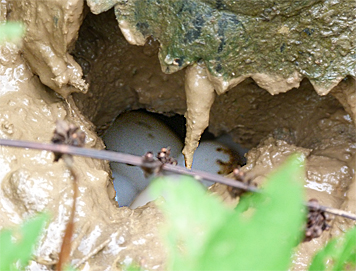
The nest was quite close to the path. Knowing that raccoons patrol the area each night, and turtle eggs are irresistible to raccoons, at my request the landscape techs quickly improvised a cage to put over the nest to keep out those wily, masked varmints.
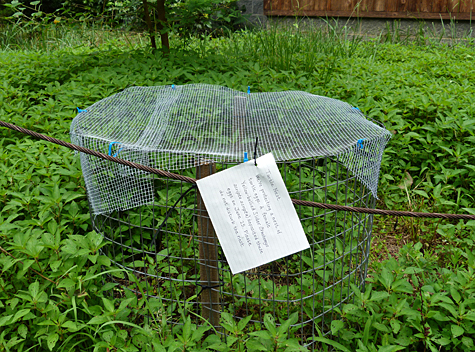
Signage was attached to the cage simply stating what it was for and when the eggs had been deposited. Although there was really nothing to see, the nest was expertly covered by the female after she laid the eggs, any onlooker’s curiosity was quickly answered by reading the little note secured to the cage. And, of course, anytime I saw Museum guests looking at the cage I was there to answer any further questions.
The incubation period for these turtles is around 90 days. The nest was watched throughout the summer and into fall. Nothing happened.
I’m aware that some turtles hatch out and overwinter inside the nest until the following spring. Each spring, typically starting in March, young turtles are seen making their way down the paths here at the Museum towards the water. Y-b turtle #92-01’s offspring must be going to overwinter in the nest.
I had thought, though, that only the eggs that were deposited late in the season, say August, would overwinter. We often see young turtles in late summer and early fall. They were surely hatched from eggs deposited in May or June. But, any turtle eggs placed in a nest in July or August are more likely to overwinter.
There was some talk about digging up the nest to see if the eggs had hatched. Some folks suggested the eggs were infertile. I began to doubt their fertility myself. Despite my doubts, I decided to wait till the spring to see if the turtles would emerge from the nest.
Several times this spring I thought again about digging up the nest. As March turned to April I began to think that the eggs were indeed infertile, that they didn’t hatch and there were no live turtles in the nest. My hesitation at digging up the nest was rewarded by what I saw on the 9th of April.
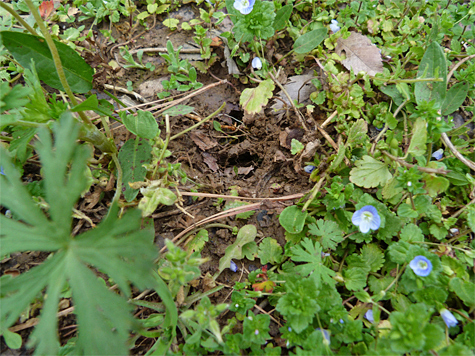
A closer look at the hole in the ground revealed one or two green and yellow objects just below the surface.
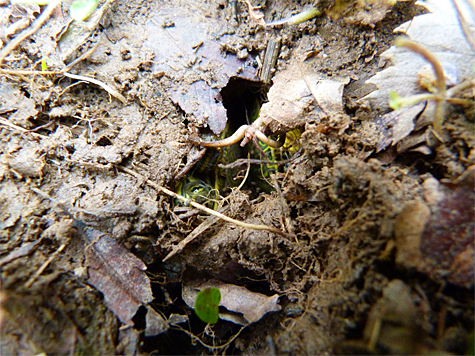
I brushed away some of the dirt and roots that blocked my view. There, I could see two young turtles on their sides, back to back (carapace to carapace) and one turtle with its carapace facing up.
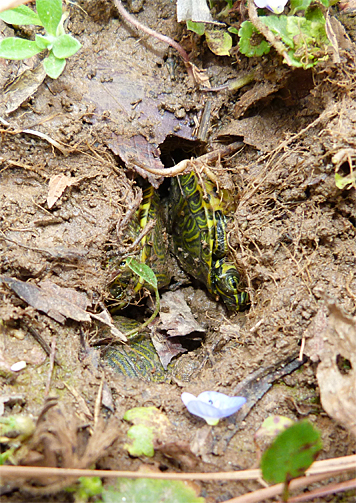
I brushed away more dirt and, I must admit, helped the turtles out by placing them on the ground just outside the hole. They were probably not going to come out on their own while I stood there watching, and I wasn’t about to leave and let them do so after having waited so long to see them. While I was gone they could slip into the water and I would never see them again. I had to get some photos.
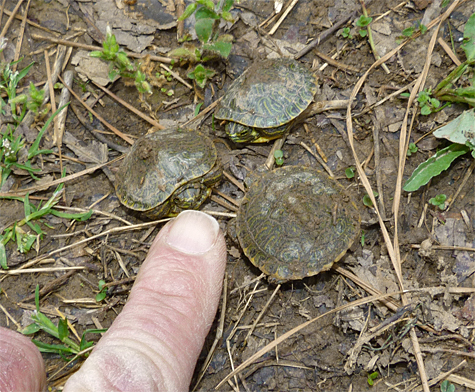
After about ten minutes of watching and waiting to see what they would do next, and with a small crowd of Museum guests forming, each turtle took off in a different direction. One turtle headed directly towards the water, another towards the wolf exhibit and the other towards the lemurs. I quickly decided to let some of the guests who were standing by get involved. The three turtles each made their way to the water via a lift by three happy Museum guests.
The eggs were deposited in the nest on June 25 of last year. The turtles probably hatched sometime in late September or early October. The young overwintered in the nest. March’s cool weather kept them from digging out until the 9th of April, 288 days after their mother laid the eggs.
I remember having seen five eggs drop into the hole last June as #92-01 laid her eggs. I believe there were more. Four eggs are visible in the top photo on this page. I can’t say what happened to the other egg or eggs. There were only three turtles in the hole that I saw. Perhaps there are other turtles just inches from where these three were huddled together that are eventually going to dig themselves out, I don’t know. You can bet, though, that I’m going to keep an eye out.
Until next time, happy herp watching!